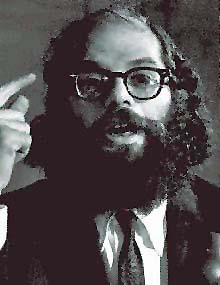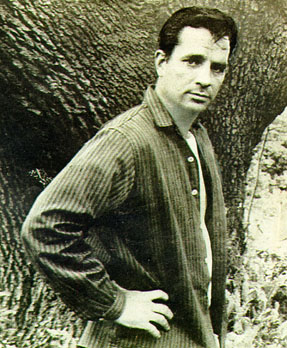Experimental Poetry
Inspired by jazz and abstract expressionist painting, experimental writers have tended to be bohemian, counterculture intellectuals who disassociated themselves from universities and outspokenly criticized "bourgeois" American society. Their poetry is daring, original, and sometimes shocking. In its search for new values, it claims affinity with the archaic world of myth, legend, and traditional societies such as those of the American Indian. The forms are looser, more spontaneous, and organic; they arise from the subject matter and the feeling of the poet as the poem is written, and from the natural pauses of the spoken language.
They can be divided into the following five schools:
The Black Mountain School
The Black Mountain School centered around Black Mountain College, an experimental liberal arts college in Asheville, North Carolina, where poets Charles Olson, Robert Duncan, and Robert Creeley taught in the early 1950s. Ed Dorn, Joel Oppenheimer, and Jonathan Williams studied there, and Paul Blackburn, Larry Eigner, and Denise Levertov published work in the school's magazines Origin and Black Mountain Review. The Black Mountain School is linked with Charles Olson's theory of "projective verse" which insisted on an open form based on the spontaneity of the breath pause in speech and the typewriter line in writing.
The San Francisco School
The San Francisco School was inspired by Eastern philosophy and religion, as well as by Japanese and Chinese poetry. The beauty of the scenery around San Francisco was also an inspiration to poets who in their poems express deep feelings for nature. Many of their poems are set in the mountains or take place on backpacking trips. The poetry looks to nature instead of literary tradition as a source of inspiration.
San Francisco poets include Jack Spicer, Lawrence Ferlinghetti, Robert Duncan, Phil Whalen, Lew Welch, Gary Snyder, Kenneth Rexroth, Joanne Kyger, and Diane diPrima. Many of these poets identify with working people. Their poetry is simple, accessible, and optimistic.
Beat Poets
The San Franciso School blends into the next grouping - the Beat poets, who emerged in the 1950s. The term beat variously suggests musical downbeats, as in jazz; angelical beatitude or blessedness; and "beat up" - tired or hurt. The Beats (beatniks) were inspired by jazz, Eastern religion, and the wandering life. These were all depicted in the famous novel by Jack Kerouac On the Road, a sensation when it was published in l957. An account of a 1947 cross-country car trip, the novel was written in three hectic weeks on a single roll of paper. The wild, improvisational style, hipster-mystic characters, and rejection of authority and convention fired the imaginations of young readers and helped usher in the freewheeling counterculture of the 1960s.
  Most of the important Beats migrated to San Francisco from America's East Coast, gaining their initial national recognition in California. The charismatic Allen Ginsberg (1926-1997) became the group's chief spokesperson. At Columbia University he befriended with Kerouac (1922-1969) and William Burroughs (1914-1997). These three were the nucleus of the Beat movement. Most of the important Beats migrated to San Francisco from America's East Coast, gaining their initial national recognition in California. The charismatic Allen Ginsberg (1926-1997) became the group's chief spokesperson. At Columbia University he befriended with Kerouac (1922-1969) and William Burroughs (1914-1997). These three were the nucleus of the Beat movement.
Other figures included publisher Lawrence Ferlinghetti (1919- ), whose bookstore, City Lights, became their gathering place. Ferlinghetti's thoughtful, humorous, political poetry included A Coney Island of the Mind (1958).
Gregory Corso (1930-2001) is remembered for volumes of humorous poems, such as the often-anthologized "Marriage."
Beat poetry is oral, repetitive, and immensely effective in readings, largely because it developed out of poetry readings in underground clubs. Beat poetry was the most anti-establishment form of literature in the United States, but beneath its shocking words lies a love of country. The poetry is a cry of pain and rage at what the poets see as the loss of America's innocence and the tragic waste of its human and material resources.
Poems like Allen Ginsberg's Howl (1956) revolutionized traditional poetry.
I saw the best minds of my
generation destroyed by
madness, starving hysterical
naked,
dragging themselves through the
negro streets at dawn
looking for an angry fix,
angelheaded hipsters burning
for the ancient heavenly
connection to the starry
dynamo in the
machinery of night...
The New York School
The poets of the New York School were not interested in overtly moral questions, and, in general, they steered clear of political issues.
The major figures of the New York School - John Ashbery, Frank O'Hara, and Kenneth Koch - met at Harvard University. Their poetry is essentially urban, cool, nonreligious, and witty with a poignant, pastel sophistication. The poems are fast moving, full of urban detail, incongruity, and an almost palpable sense of suspended belief.
New York City is the fine arts center of America and the birthplace of abstract expressionism, a major inspiration of this poetry. Most of the poets worked as art reviewers or museum curators, or collaborated with painters. Perhaps because of their feeling for abstract art, which distrusts figurative shapes and obvious meanings, their work is often difficult to comprehend, as in the later work of John Ashbery (1927- ), perhaps the most critically esteemed poet of the late 20th century.
Surrealism and Existentialism
The Surrealist and Existentialist school is hard to define because of unclear geographical underpinning. The Surrealists express the unconscious through vivid dreamlike imagery, and much poetry by women and ethnic minorities that has flourished in recent years. Though superficially distinct, surrealists together with feminists and minorities appear to share a sense of alienation from mainstream literature. Not until the 1960s did surrealism (along with existentialism) become domesticated in America under the stress of the Vietnam conflict.
During the 1960s, many American writers, such as W.S. Merwin, Robert Bly, Charles Simic, Charles Wright, and Mark Strand, saw their role-models in French and Spanish surrealism for its pure emotion, its archetypal images, and its models of anti-rational, existential unrest.
|

